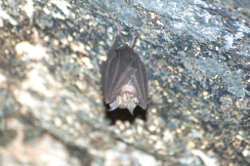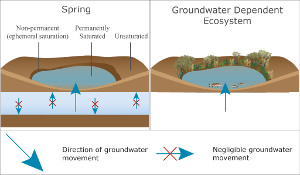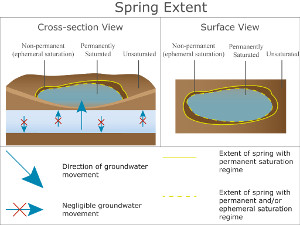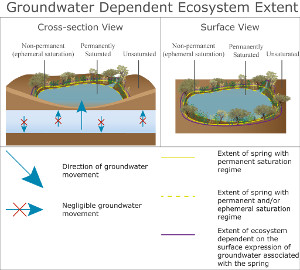|
|
Groundwater dependent ecosystem FAQsThis page provides information about Queensland GDE mapping conducted for areas of Queensland. This includes the relationship between GDE mapping and wetland mapping in Queensland, how to access GDE mapping, detail on what information is contained in the mapping, how to use the mapping and much more. GDE mapping FAQ PDF versionRelated informationSearch FAQWhat are groundwater dependent ecosystems (GDEs)?See GDE ecology page Why are groundwater dependent ecosystems (GDEs) important?GDEs provide an array of ecological benefits including provision of:
GDEs provide economic values including provision of:
GDEs provide social and cultural values including provision of:
Groundwater supports terrestrial and aquatic ecosystems by supporting vegetation and providing discharge to channels, lacustrine and palustrine wetlands, and both the estuarine and marine environment. Groundwater also plays a critical role during extended dry periods in maintaining refuges for flora and fauna. How does urban and rural development affect groundwater dependent ecosystems (GDEs)?Development can have impacts on GDEs including, but not limited to:
What are the types of groundwater dependent ecosystems (GDEs)?Queensland GDE mapping shows the geographic extent of three types of GDEs[1] based on the type of groundwater reliance. This typology is useful for management because it allows GDEs to be separated into easily recognisable types that permit the use of similar techniques and approaches for the identification of GDEs. The Queensland GDE mapping also contains attributes which provide further information about each GDE. The three types of GDEs are:
What are the subtypes of groundwater dependent ecosystems (GDEs)?Ecosystems dependent on the surface expression of groundwater
Ecosystems dependent on the subsurface presence of groundwater
Ecosystems dependent on the subterranean presence of groundwater
What subtypes of groundwater dependent ecosystems are mapped in the Queensland GDE mapping?
What is a spring?Springs are hydrogeological features by which groundwater discharges naturally to the land surface or cave. This includes springs with:
Click here for more information on springs What is the difference between a spring and a groundwater dependent ecosystem (GDE)?An ecosystem on the land surface may be dependent on this surface expression of groundwater (whether the expression is permanent or non-permanent, diffuse or point source, or dynamic or static in spatial location) and this ecosystem would be groundwater dependent ecosystem. Are all groundwater dependent ecosystems (GDEs) associated with a spring?Not all groundwater dependent ecosystems are associated with a spring. Ecosystems dependent on the sub-surface presence of groundwater (e.g. a terrestrial ecosystem) will not be associated with a spring as the groundwater will not express at the surface. An ecosystem dependent on the surface expression of groundwater will always be associated with a spring, for example, palustrine wetland (e.g. swamps), lacustrine wetland (e.g. lakes), riverine wetland (e.g. streams) and estuarine and near-shore marine. How far does a spring extend on the surface?The surface extent of the spring is limited to the spatial extent where groundwater discharges to the surface. Therefore a spring does not extend downslope despite the fact that the groundwater discharged by a spring might move downslope. For example, a spring at a fixed spatial location with a permanent saturation regime will be defined by the extent of the spring vent. However, a groundwater dependent wetland on the surface associated with the spring may extend much further than the spring extent. How far does a groundwater dependent ecosystem (GDE) extend from a spring?There is no standard distance a groundwater dependent ecosystem extends from a spring as they reflect local conditions. For example, a spring with diffuse discharge into a river can support surface expression riverine groundwater dependent ecosystems for several hundred meters to kilometres depending on the spring flow rate, spring extent, and local hydrogeological characteristics. In arid environments, a spring with a permanent saturation regime and a fixed spatial location may only support a surface expression palustrine groundwater dependent ecosystem extending less than one hectare from the spring vent. What is the relationship between the Queensland Springs Dataset, the Queensland Wetlands Data, and the Queensland Groundwater Dependent Ecosystems Data Sets?The Queensland Springs DatasetThe Queensland Springs Dataset provides point locations of springs, hydrogeological features by which groundwater discharges natural to the land or cave surface. This dataset includes springs with permanent and non-permanent (i.e. intermittent or ephemeral) saturation regimes, dynamic or static geographic locations, and diffuse or point source geographic locations. The Queensland Springs Dataset is the point of truth for spring information in Queensland. The dataset is presented as two layers:
The Queensland Groundwater Dependant Ecosystems DatasetThe Queensland Groundwater Dependent Ecosystems Data – surface expression points data set provides information on small ecosystems dependent on the expression of groundwater at the Earth’s surface (i.e. spring ecosystems). The Queensland Springs Dataset is a key input into the Queensland Groundwater Dependent Ecosystems Data – surface expression points data set. A subset of input data (e.g. active springs) as outlined in mapping rule-sets is enhanced with a range of groundwater dependent ecosystem attributes. Queensland Wetland Data - points datasetThe Queensland Wetland Data – points data set provides information on small wetland ecosystems (e.g. palustrine and lacustrine spring wetlands, water bodies, etc.) including both groundwater dependent and non-groundwater dependent wetlands. The Queensland Springs Dataset is one input into the Queensland Wetland Data –points data set. Other inputs include permanent refuge waterbodies. The Queensland Wetland Data –points data set is a subset of all input data (e.g. active springs and permanent waterholes) enhanced with a range of wetland attributes. Why was the Queensland groundwater dependent ecosystem (GDE) mapping produced?Agreements were made, under the 1994 Council of Australian Governments Water Reform Framework and the 2004 Intergovernmental Agreement on a National Water Initiative to include provisions of water for the environment in groundwater management and planning. Understanding and managing GDEs and their associated function and value is central to attaining these outcomes. The Queensland Government has recognised the need to consistently map ecosystem dependence on groundwater and to make this information accessible to decision makers in a manner which is consistent with existing data sets. The Queensland GDE mapping project contributed to the development and review of a National GDE Atlas through knowledge sharing and evaluation of both methods and products. This method relies on the use of an iterative consultative process to ensure the mapping is developed with the optimal use of both expert knowledge and existing spatial information. How is the Queensland groundwater dependent ecosystem (GDE) mapping produced?Queensland GDE mapping is produced using a consultative process that collates expert knowledge about GDEs in a landscape and develops mapping rules to identify those ecosystems through the ‘Walking the landscape’ process. These mapping rules are then applied to the best available spatial data in the Geographic Information System (GIS) to delineate areas that are likely to be groundwater dependent. Information about relevant landscape processes is captured in pictorial conceptual models. These conceptual models collate valuable supporting information to improve our understanding of the landscape processes that produce GDEs, the broader issues of context and function of GDEs, and to assist in the estimation of GDE extent delineated in the GDE mapping. The Queensland Government has integrated regional ecosystem and wetland mapping data into the GDE mapping process. The Queensland GDE mapping is produced with the aim to ensure that the mapping products fit with existing mapping programs and could be maintained and updated into the future. Where can I find the Queensland Groundwater Dependent Ecosystem (GDE) Mapping Method?The GDE mapping background and method can be found here. Where can I find the attribution for the Queensland groundwater dependent ecosystem (GDE) mapping?The GDE attributions can be found on the groundwater dependent ecosystem spatial datasets and attribute fields page. How can I use the KMLs?To find out how to use KMLs go to the get mapping help page. What are the major source data sets for the groundwater dependent ecosystem (GDE) mapping?The GDE mapping combines several major source datasets to create GDE mapping:
What are the Queensland groundwater dependent ecosystem (GDE) pictorial conceptual models?Pictorial conceptual models are representations of observed objects, phenomena and processes in a logical and objective way with the aim of constructing a formal system whose theoretical consequences are not contrary to what is observed in the real world. Pictorial conceptual models evoke the real world by presenting enough visual cues to give the reader a clear context for the relationships, processes or elements the model seeks to explain[3]. Queensland GDE pictorial conceptual models capture the collective knowledge available of the key conditions controlling groundwater and ecosystem interaction in a specific landscape. Why are the Queensland groundwater dependent ecosystem (GDE) pictorial conceptual models produced?Queensland GDE pictorial conceptual models are produced to collate cross-disciplinary knowledge regarding the components, processes and interrelationships in a system that are critical to the presence, function and form of GDEs. GDE pictorial conceptual models are a tool that supports the communication of technical scientific concepts to end users to increase understanding and assist environmental managers in decision making. Was field verification of Queensland groundwater dependent ecosystem (GDE) mapping carried out?Where possible, existing research has been used to corroborate the expert knowledge used in the mapping process (see What the confidence rating means?). Field verification, including either qualitative or detailed quantitative measurements of GDEs at specific locations, has not been undertaken as part of the current GDE mapping process. Although such an assessment would significantly improve the accuracy of the mapping, this type of work would require significant funding and resourcing and is often not practical to complete over large areas. Field assessment techniques are outlined in the Australian groundwater-dependent ecosystems toolbox. Will the Queensland groundwater dependent ecosystem (GDE) mapping information be updated?The intent is that the GDE mapping will be updated in line with resources and needs. This will take the form of:
What is the link between the Queensland groundwater dependent ecosystem (GDE) mapping and other mapping?The GDE mapping combines information from multiple source datasets (including wetland and regional ecosystem information). The source datasets provide the point, line and area features in the GDE mapping. Further information on how GDE mapping links to other mapping products in Queensland can be found here. What is the relationship between the National Groundwater Dependent Ecosystems Atlas (National GDE Atlas) and the Queensland GDE mapping?The National GDE Atlas combines nationwide layers of satellite remote sensing data with existing literature and mapping. Queensland’s GDE mapping builds on existing information, including wetland mapping, regional ecosystem mapping, a spring and small waterholes database, and drainage lines. This information is combined with feedback from a broad range of experts. The definitions and mapping attributes used in the National GDE Atlas and the Queensland GDE mapping were developed collaboratively. Mapping data sets from the Queensland GDE mapping are available for integration into the National GDE Atlas when it is next updated. How should the Queensland groundwater dependent ecosystem (GDE) mapping be used?The Queensland GDE mapping products are tools to support natural resource management decision making. The mapping indicates the likely locations of GDE at a regional scale and provides descriptions and system understanding where possible of the ecosystems. The GDE mapping should be used with other information to assist environmental managers in making resource management decisions aimed at the sustainable management of key environmental assets which may be dependent on groundwater. The Queensland GDE mapping is most suitable for use at the regional scale and can indicate where finer scale assessments may be necessary. While the mapping products may provide an input to policy and legislative processes they should not be used as statutory maps. Map users are advised to check the GDE mapping confidence rating. The Queensland GDE mapping does not presently indicate the detailed level of ecosystem dependence on groundwater, the values of the ecosystem, and the condition of the ecosystem or their environmental water requirements. Rather these maps should be used to inform more detailed local-scale assessment of GDEs including field assessments. What does the Queensland groundwater dependent ecosystem (GDE) confidence rating mean?Each ecosystem identified as potentially groundwater dependent has been assigned a confidence rating to indicate the level of confidence experts had in their prediction that the ecosystem is using groundwater as opposed to other water sources (e.g. soil water or surface water). Confidence is rated according to the level of confidence experts had in the developed mapping rule set that identified the specific ecosystem as groundwater dependent. The confidence ratings of GDE mapping are:
Does the Queensland groundwater dependent ecosystem (GDE) mapping contain information on the level of groundwater use by an ecosystem?The Queensland GDE mapping contains a number of attributes describing the level of groundwater use by an ecosystem, although these may not be populated for all GDEs. Flora and fauna within an ecosystem may also have different levels of groundwater use that can vary spatially and temporally. Factors that may affect groundwater use include flora physiology, availability of other water sources, existing hydrological regime and groundwater quality. Does the Queensland groundwater dependent ecosystem (GDE) mapping contain information on ecosystem condition?The Queensland GDE mapping contains limited information about ecosystem condition. The GDE mapping contains a few attributes describing hydrological and salinity modification which is derived from the source wetland mapping dataset. Other GDE condition information is not included in the GDE mapping. As the GDE mapping is linked to wetlands and regional ecosystem mapping, the attributes in these latter data sets may contain some additional information which might help in some condition assessment processes. How can I view the Queensland groundwater dependent ecosystem (GDE) mapping products?To view the mapping products go to the following pages:
How can I get or view the Queensland groundwater dependent ecosystem (GDE) mapping?To view the GDE mapping go to the get mapping help page. Where can I find the Queensland groundwater dependent ecosystem (GDE) pictorial conceptual models?To view the GDE conceptual models go to the conceptual models page. Where can I find the metadata for Queensland groundwater dependent ecosystem (GDE) mapping?To find and view the GDE metadata go to the metadata page. Is the whole polygon delineated as a Queensland groundwater dependent ecosystem (GDE) in all cases?Each GDE extent shows an area where groundwater and ecosystems interaction may be occurring; however, not all ecosystems within that area may necessarily be groundwater dependent. For example, a regional ecosystem GDE polygon may be identified as potentially groundwater dependent but in fact only a portion of the vegetation within the identified polygon depends on groundwater to maintain communities, processes and services and is therefore groundwater dependent. An estimate of the proportion of an area that is groundwater dependent is provided in the attribute field ‘GDE_PCT’. The values are as follows:
Are all groundwater dependent ecosystems (GDEs) shown in the Queensland GDE mapping?Not all GDEs are identified and captured in the Queensland GDE mapping due to a large reliance on existing data sets and landscape-scale analysis supported by expert knowledge. GDEs may not be identified and captured where ecosystems are:
Why are there overlapping groundwater dependent ecosystems (GDEs)?Overlapping GDEs could indicate:
What do blank and white spaces in the Queensland groundwater dependent ecosystem (GDE) mapping mean?Blank or white space on the map could indicate that the area:
Why may borders be visible in the Queensland groundwater dependent ecosystem (GDE) mapping?Visible borders on the map could indicate:
What geographic area does the Queensland groundwater dependent ecosystem (GDE) mapping cover?What scale is the Queensland groundwater dependent ecosystem (GDE) mapping?To find and view the GDE metadata go to the metadata page. How accurate is the Queensland groundwater dependent ecosystem (GDE) mapping?To find and view the GDE metadata go to the metadata page. What is the currency of the Queensland groundwater dependent ecosystem (GDE) mapping?To view the GDE go to the mapping version history on the GDE mapping background page. Where can I find technical specifications for the Queensland groundwater dependent ecosystem (GDE)mapping?The technical specifications for the Queensland GDE mapping data are available on request. The following technical specifications are available:
Pages under this sectionReferences
Last updated: 12 May 2015 This page should be cited as: Queensland Government, Queensland (2015) Groundwater dependent ecosystem FAQs, WetlandInfo website, accessed 8 May 2025. Available at: https://wetlandinfo.des.qld.gov.au/wetlands/facts-maps/gde-background/gde-faq/ |

 — Department of the Environment, Tourism, Science and Innovation
— Department of the Environment, Tourism, Science and Innovation





